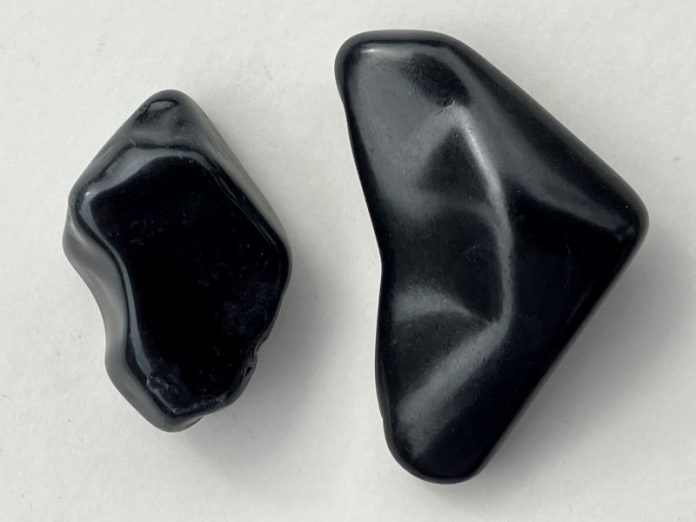
Jet stone is one unusual stone. Used as lapidary material for millennia, it gets no respect in mineralogical circles. Among ten common rock and mineral guidebooks, seven don’t even list jet stone in the index. The others? One has a picture with a one-sentence caption. Another offers only a brief paragraph.
What’s up? Well, for one thing, jet isn’t officially considered a mineral. A “mineraloid” is as generous as mineralogists allow. One even refers to it dismissively as simply “a rock.” Read on, then join my dismay for those who malign such a storied stone.
A Gem With Organic Origins

Basically, jet is coal. But no ordinary coal! Most coal was formed in freshwater swamps. Dense mats of vegetation left the immense beds we mine today. Then there’s lignite. Lignite also typically formed in freshwater environments but is less fully compressed. Sometimes called “brown coal,” it retains evidence of its original woody structure. Jet is often compared to lignite, but try to employ lignite as lapidary material and it crumbles in your hands.
To appreciate the distinct nature of jet, step back to the Jurassic. The conifer Araucaria dotted the landscape. Although currently restricted as a native species to Chile and Argentina, ancient relatives once ranged broadly. It’s informally referred to as Monkey Puzzle Tree because an Englishman remarked “it would even puzzle a monkey to climb that tree.”
“Classic” jet comes from individual Araucaria trees that fell on land and floated to sea. Once waterlogged, they sank and became buried in the muck that eventually turned to claystone. Compressed under the weight of sediments, the trees lost much of their organic content until primarily carbon was left, with a smidgeon of other elements.
Some forms of jet do come from freshwater deposits. These are referred to as “soft jet” versus “hard jet” from marine settings. Deposited as driftwood, jet usually occurs in small lenses recognizable as compressed logs. Like lignite, it retains a degree of its original woody structure, which is sometimes obvious to the naked eye but more often requires magnification.
Opaque and dull black or dark brown when dug up, jet is shiny black when polished. The term “jet” is applied to materials that while perhaps forming under dissimilar conditions nonetheless have similar properties.
What’s in a Name? Derivation of the Word “Jet”Jet comes from the French word jaiet which refers to the ancient town of Gagae in present-day Turkey, where jet was mined. Indeed, jet is sometimes called gagates and ancient Greeks called it “the stone of Gagates.” Jetblack means as black as black can be. |
Jet Stone in the Lapidary Workshop
Some call jet “Black Amber.” Like amber (another plant-based organic gemstone), it is easy to work because of Mohs hardness ranging from 2.5 to 4. While low on the hardness scale, jet stone is tough because of its fibrous microstructure. Fine-grained and compact, it takes such a glossy polish that in the days of old, it was used as a mirror. But it can also be buffed for a velvety matte finish. Its lightweight (specific gravity 1.30-1.35) makes it comfortable as earrings or necklaces, a comfort augmented by classy black.
These properties make jet a superb lapidary material. It can be cabbed, faceted or carved. Because it contains hydrocarbons, working jet releases an oily odor, so good ventilation is recommended.
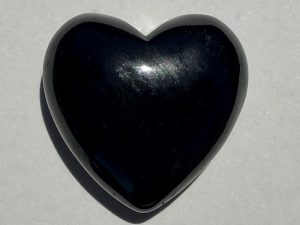
A Gem of Antiquity Across Europe
Archeological finds show jet jewelry has been crafted in Europe for thousands of years. In France, a pendant uncovered in Marsoulas Cave has been dated to the Paleolithic period over 12,000 years ago, and a carving from 10,000 B.C. was uncovered in Baden-Württemberg, Germany. In Britain, jet artifacts date to the Neolithic period.
Romans embraced jet bangles, hair pins and “Medusa head” pendants, particularly after the colonization of Britain, where they used jet beachcombed from present-day Whitby and crafted in Eboracum (York). Romans exported such items: jewelry with similar styles has been found in the Rhineland. But when the Romans left Britain, their interest in jet declined.
While the Roman Empire eventually fell, not so the interest in jet. Relics, particularly of a religious nature, are common from the Middle Ages. English monks took a liking to jet crosses and rosary beads. As monks fingered their rosaries, Vikings raiding their cathedrals also took a liking to jet. Snakes were a common theme of their jewelry.
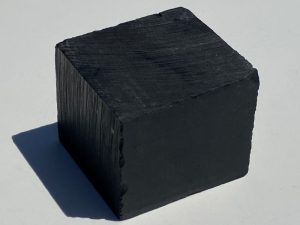
Jet Stone in the “New World”
While Western usage is best documented, other cultures crafted jet. Native Americans carved jet beads and ceremonial fetishes. In the 1500s, Spanish explorers reported its use among the Acoma Pueblo in New Mexico. Deposits they’ve mined have been labeled “Acoma jet.” Carvings have been found among Anasazi artifacts at Chaco Canyon. Native American craftsmen still use jet, often inlaid in silver settings alongside turquoise.
The Victorian Heyday: A Stone for a Mourning Queen
Jet gained prominence in Britain when Queen Victoria incorporated it into her mourning dress upon the death of her husband Prince Albert in 1861. Such was Victoria’s popularity, her choice of jet— Whitby jet, in particular—set the standard for mourning jewelry in England. It allowed for the wearing of refined jewelry that was nonetheless appropriately somber.
While most sources cite the use of jet by the Victorian court following the death of Prince Albert, it actually preceded that sad event when Queen Victoria wore jet at the 1857 funeral of her cousin Princess Victoria of Saxe-Coburg and Gotha. From the 1850s into the 1870s, jet reached its height of popularity. In addition to jewelry, it was crafted into novelties ranging from beads and buttons to cups and candlesticks. Demand buoyed Whitby. Why this isolated little town in the North Yorkshire region of England’s east coast?
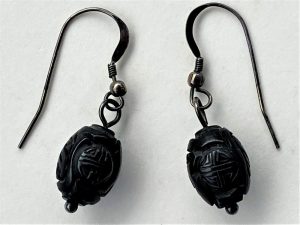
The Enduring Legacy of Whitby, the Premier Source
Geologically speaking, Whitby jet comes from fossilized wood in the Jurassic Jet Rock unit of the Mulgrave Shale Member of the Whitby Mudstone Formation. Chunks erode from coastal deposits, and the first jet worked in this area—preceding even the Romans—came from beach-combed pieces. As that supply became over-harvested, mines were dug from which jet continued to be plucked into the 1900s.
Such is its quality, Whitby jet is considered the gold standard. During Victoria’s reign, Whitby boasted a full-scale jet industry. When demand fell, it fell with a thud. The industry enjoyed a boost when 1920s flappers sought ultra-long lightweight necklaces to grace their slender necks, but it never fully recovered, and jet substitutes—particularly newfangled plastics—further cut into demand for true jet.
Only a handful of practitioners remained by the 1940s, and that’s the case today. One is W. Hamond (est. 1860), which bills itself as “The Original Whitby Jet Shop.” Another is The Ebor Jetworks, run by the Steele family. Sarah Steele conducts academic work on this unusual stone, her family shop helps keep alive an art that’s nearly been lost.
Whitby Jet: Learn, See, BuyExplore Whitby jet in-depth (and buy authentic pieces) via these websites: • The Whitby Museum, whitbymuseum.org.uk • W. Hamond, whamond.com/en-us • The Ebor Jetworks, eborjetworks.co.uk |
A New, Tempered Heyday?
Most sources tell you jet is rarely used today. However, those who say so obviously haven’t taken part in perennial Goth revival movements. Coinciding with the rise of Punk Rock, Goth fashion—with an emphasis on the morbidly black—took off in the 1970s and ’80s when it co-opted ideas from Victorian mourning attire. Demand grew for jet beads and antique jewelry, and new jewelers took up the craft. In the 1990s, the fashion morphed into what some have derisively dubbed “mall Goths.” It continues flirting around the fringes of fashion.
Jet has been embraced by Wiccans and New Age followers who make pilgrimages to Whitby around Halloween for various festivals. One draw is the featured role of Whitby in Bram Stoker’s Dracula, in which the Transylvanian vampire terrorizes the town, which now hosts an October Bram Stoker Film Festival. At recent gem shows in the U.S., there have been jet slabs, hearts, and, yes, jet jewelry. Those in the know say it’s a trend that refuses to die, so never count Whitby jet down and out!
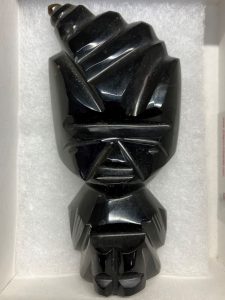
Jet Stone Look-Alikes, Synthetics, & Fakes
Whenever anything becomes popular, cheap imitations follow. Jet is a case in point. Look-alikes have been crafted from natural materials: anthracite, obsidian, onyx and albertite (an asphalt derived from oil shales). More often, they’ve come from man-made materials: glass, ultra-vulcanized rubber (e.g., vulcanite, ebonite), gutta-percha, and the bane of modern life: plastics. While plastics are common today, glass substitutes were in vogue at the height of jet’s popularity. These were called French jet or Vauxhall glass for cachet.
Simple tests reveal imposters. Black glass and onyx are heavier and cold to the touch. Jet stone is warm. Jet has a brown streak if rubbed across a streak plate; however, vulcanite also leaves a brown streak. Jet takes a static electrical charge if rubbed with a cloth. Finally, some imitators like albertite, don’t achieve the high gloss of jet while others, such as ebonite, fade over time.
Another giveaway is price. Authentic Victorian-era jet jewelry goes for several hundred dollars whereas vulcanite or guttapercha look-alikes typically go for under $100. But buyer beware! You’ll find listings for “gutta percha jet.” There’s no such thing. Jet is jet. Gutta-percha is gutta-percha (a latex derived from a tropical tree). Craftsmen found it easy to mold; thus, there may be more nineteenth-century gutta percha lookalikes than jet on the market.
Of course, there’s always the ultimate test: burn that pendant you bought for $795. When placed in a flame, jet stone burns like coal with a smoky yellow flame, produces soot and gives off a coal-like smell but doesn’t “cake.” Once your pendant is dust, at least you’ll know it was real!
Sources From Around the World
Purists claim only material from Whitby is true jet, but lignite and coal with jet-like qualities are found worldwide. Asturias, Spain, is a notable historic source. Like Whitby jet, material there hails from the Jurassic and is high quality. France supported several mines in the 18th and 19th centuries and planned to export jet to Whitby workshops in 1871, a plan aborted when the French material was deemed inferior. Other countries with commercially viable deposits in Europe include Portugal, Germany, Austria, Poland, Italy and Russia. Quality material from Turkish deposits is called Oltu Stone.
Native Americans mined jet stone not only in New Mexico but also in Utah, Colorado and Arizona. To the east, there’s a deposit in Anne Arundel County, Maryland, while in Canada, Nova Scotia’s Pictou County is noteworthy.
Jet Stone’s Spiritual Mystique
There’s something mystical about jet. Victorians honored the spirits of the dead with it. Similarly, some Native Americans believed it brought comfort upon a relative’s death. English monks and Turks alike used it for prayer beads. It has long been valued for supposed spiritual connections with both the sacred and the occult. Such vibes go way back.
Romans viewed it as both magical and medicinal. Jet stone amulets and pendants were said to divert the gaze of “the evil eye.” Pliny the Elder wrote of jet’s supposed cures, whether powdered and mixed with water or wine to alleviate toothaches and assist women in labor, mixed with beeswax to shrink tumors, or mixed with bone marrow for snakebite. Folks also burned it and inhaled fumes for varied cures.
Similar beliefs continued into medieval times and even today. Jet stone has been embraced by New Age followers who say it will purify and ground a person with a nurturing blanket. Witches and Wiccans pair it with amber as complementary tears of the Moon: tears of golden joy and black sorrow, day and night, life and death. Jet: a black beauty well fit to commemorate the end of the endless cycle of life.
This story about jet stone previously appeared in Rock & Gem magazine. Click here to subscribe. Story and photos by Jim Brace-Thompson.














